| Norfolk, VA – 2022 | |
| Population | 232,995 |
| Median Household Income | $61,090 |
| Adults with a College Degree* | 65,096 |
| Median Age | 32.7 |
| Median Housing Value | $269,500 |
Source: U.S. Census Bureau, 2022 American Community Survey 1-Year Estimates
*Includes adults aged 18-24 with a Bachelor’s degree or higher and those 25 and older with an Associate’s degree or higher.
Companies located in areas with an affordable cost of living are better able to attract and retain skilled employees. Greater Norfolk’s national average cost allows companies to offer competitive wages to employees while maintaining reasonable labor expenses. In turn, this increases the value of employee earnings and company profits moreover other cities across the country. Living in the Hampton Roads region is cheaper than the national average in terms of housing, transportation, and health care.
The Cost of Living Index is interpreted as follows. The national average is set as the base of comparison and is thus 100. Any value above 100 indicates the Cost of Living in the selected area is higher, meaning it is more expensive to live there compared to the national average. Any value below 100 indicates the Cost of Living in the selected area is lower, meaning it is cheaper to live there compared to the national average. In the table for the Norfolk, VA MSA Cost of Living, the Composite Index is 100.2, meaning it is very slightly more expensive to live in the Norfolk, VA MSA compared to the national average, or, it is 0.2% more expensive to live in the Norfolk, VA MSA compared to the national average.
Norfolk, VA MSA Cost of Living Index 2023 Annual Average | |
| Category | Index (National Average = 100.0) |
| Composite Index | 100.2 |
| Groceries | 100.3 |
| Housing | 93.1 |
| Transportation | 96.2 |
| Health Care | 94.9 |
Source: The Council for Community and Economic Research (C2ER), Cost of Living Index, 2023 Annual Average, Section 1 Index, Metropolitan Statistical Area (MSA) – Urban Area Noted
The overall Cost of Living in the Norfolk, VA MSA is lower than the Cost of Living in many of its direct competitors, as noted in the accompanying table, making it a very attractive location for businesses.
Cost of Living Index – 2023 Annual Average
| MSA – Urban Area Noted | 100% Composite Index |
| Charleston, SC | 98.2 |
| Atlanta, GA | 98.3 |
| National Average | 100.0 |
| Norfolk, VA | 100.2 |
| Philadelphia, PA | 101.5 |
| Hartford, CT | 102.7 |
| Chicago, IL | 113.4 |
| Newark, NJ | 115.5 |
| Miami, FL | 116.9 |
| Washington, D.C. | 146.8 |
| New York County, NY (Manhattan) | 225.2 |
| Source: The Council for Community and Economic Research (C2ER), Cost of Living Index, 2023 Annual Average, Section 1 Index, Metropolitan Statistical Area (MSA) – Urban Area Noted | |
Norfolk’s median age of 33 is young. Early career workers 18-24 are 16% of the population, much higher than the national average of 9%. With a slightly higher than average (40%) prime-working-age adults aged 25-54, Norfolk has a robust workforce at all experience levels.
Norfolk Residents by Age Group – 2021 | ||
| Age Range | Number of Residents | Percent of Residents |
| < 18 | 46,791 | 20.1% |
| 18 – 24 | 36,162 | 15.5% |
| 25 – 34 | 42,698 | 18.3% |
| 35 – 44 | 30,022 | 12.9% |
| 45 – 54 | 21,613 | 9.3% |
| 55 – 64 | 25,432 | 10.9% |
| 65+ | 30,277 | 13.0% |
| Total | 232,995 | 100.0% |
| Source: U.S. Census Bureau, 2022 American Community Survey 1-Year Estimates, Table S0101 – Age and Sex | ||
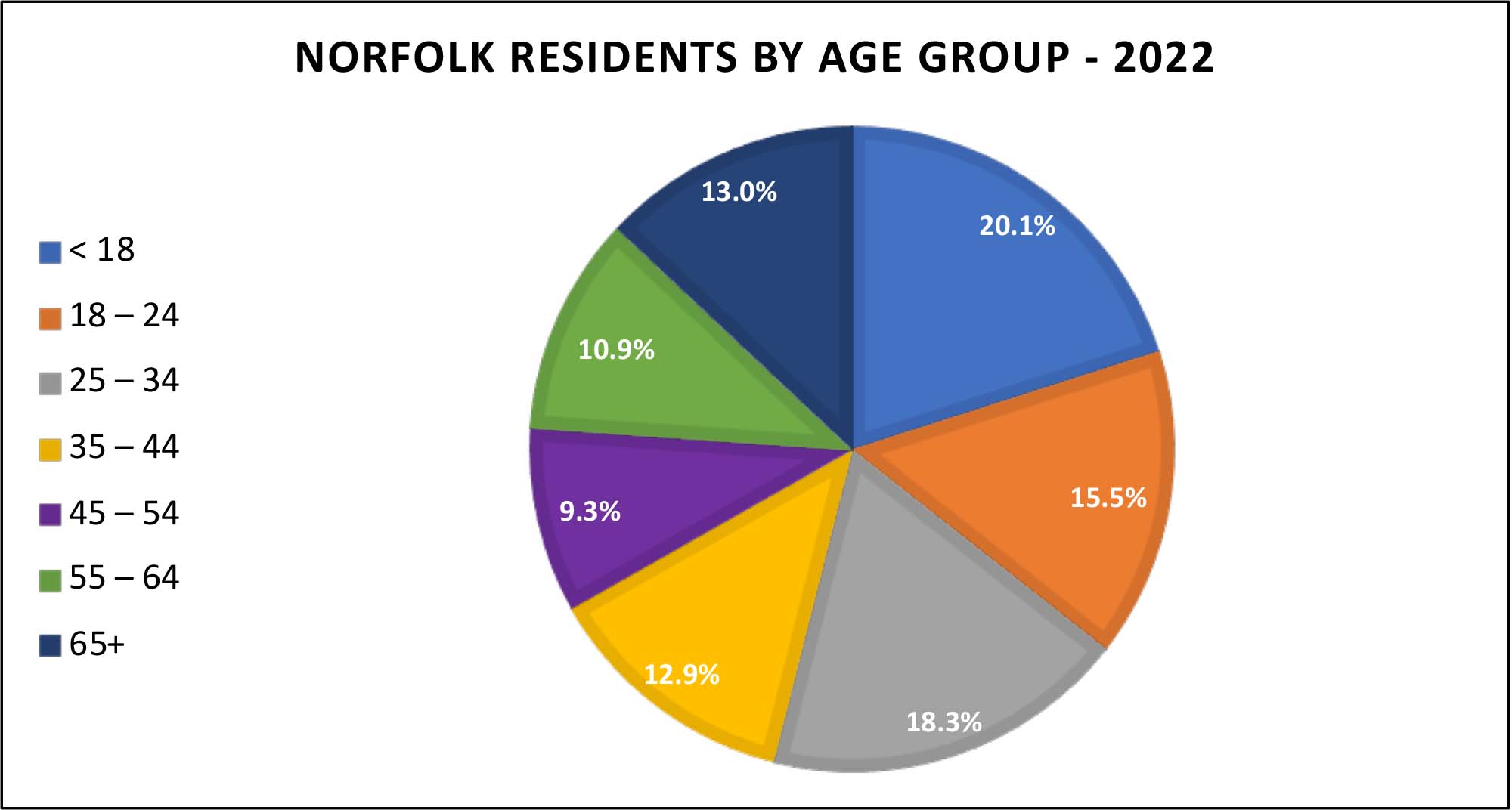
Norfolk is a very diverse locality representing individuals of many races and ethnicities. This diversity of race, ethnicity, and culture contributes to diversity in businesses.
| Norfolk Residents by Race – 2022 | ||
| Race | Number of Residents | Percent of Residents |
| White | 103,192 | 44.3% |
| Black or African American | 91,839 | 39.4% |
| Two or more races | 19,807 | 8.5% |
| Asian | 8,563 | 3.7% |
| All Other* | 9,594 | 4.1% |
| Total | 232,995 | 100.0% |
| *All Other includes Some Other Race, American Indian & Alaska Native, and Native Hawaiian & Other Pacific Islander. | ||
| Source: U.S. Census Bureau, 2022 American Community Survey 1-Year Estimates, Table DP05 – ACS Demographic and Housing Estimates |
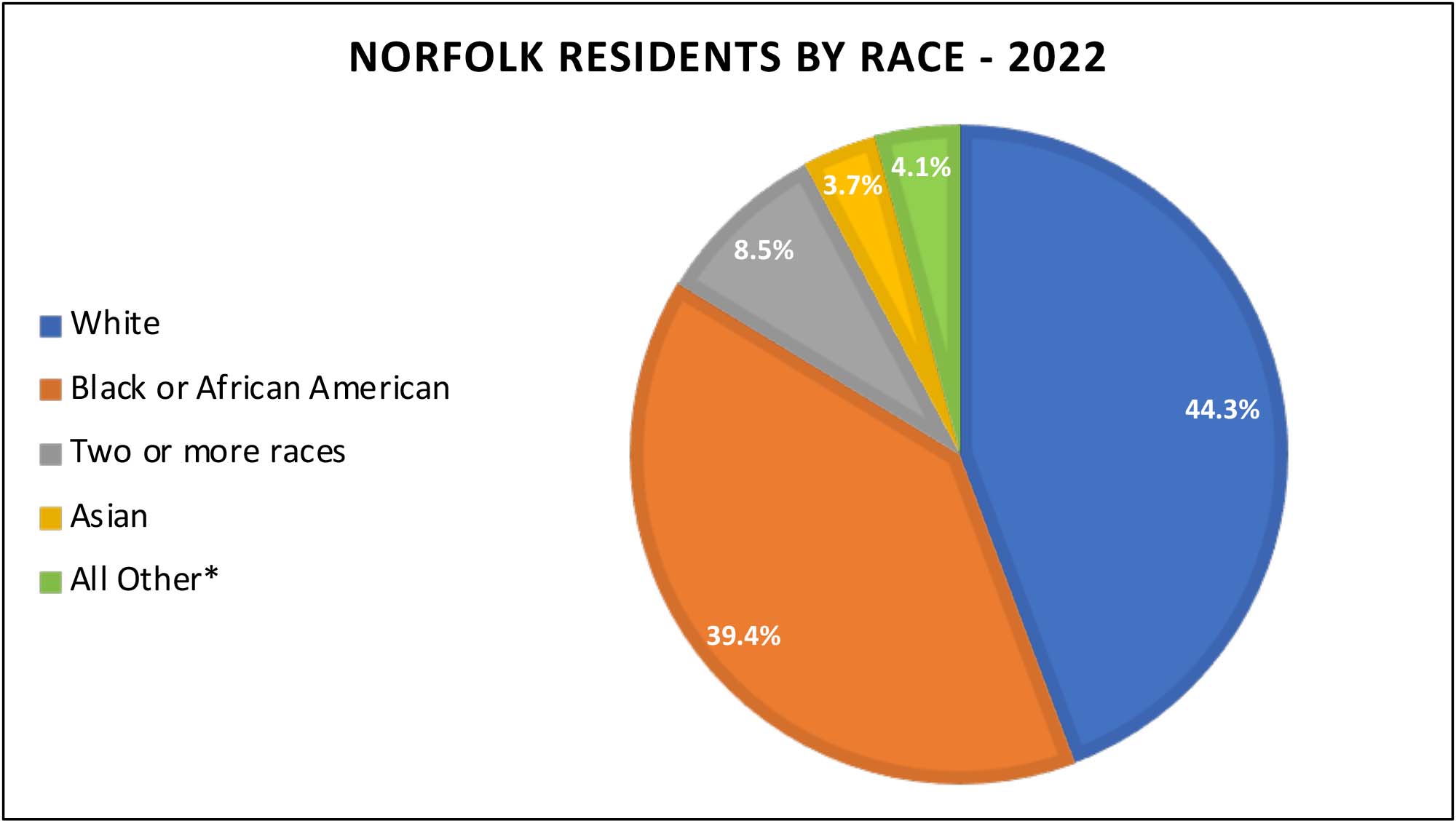
Norfolk Residents by Ethnicity – 2022 | ||
| Ethnicity | Number of Residents | Percent of Residents |
| Hispanic or Latino (of any race) | 21,628 | 9.3% |
| Not Hispanic or Latino | 213,605 | 90.7% |
| Total | 232,995 | 100.0% |
| Source: U.S. Census Bureau, 2022 American Community Survey 1-Year Estimates, Table DP05 – ACS Demographic and Housing Estimates | ||
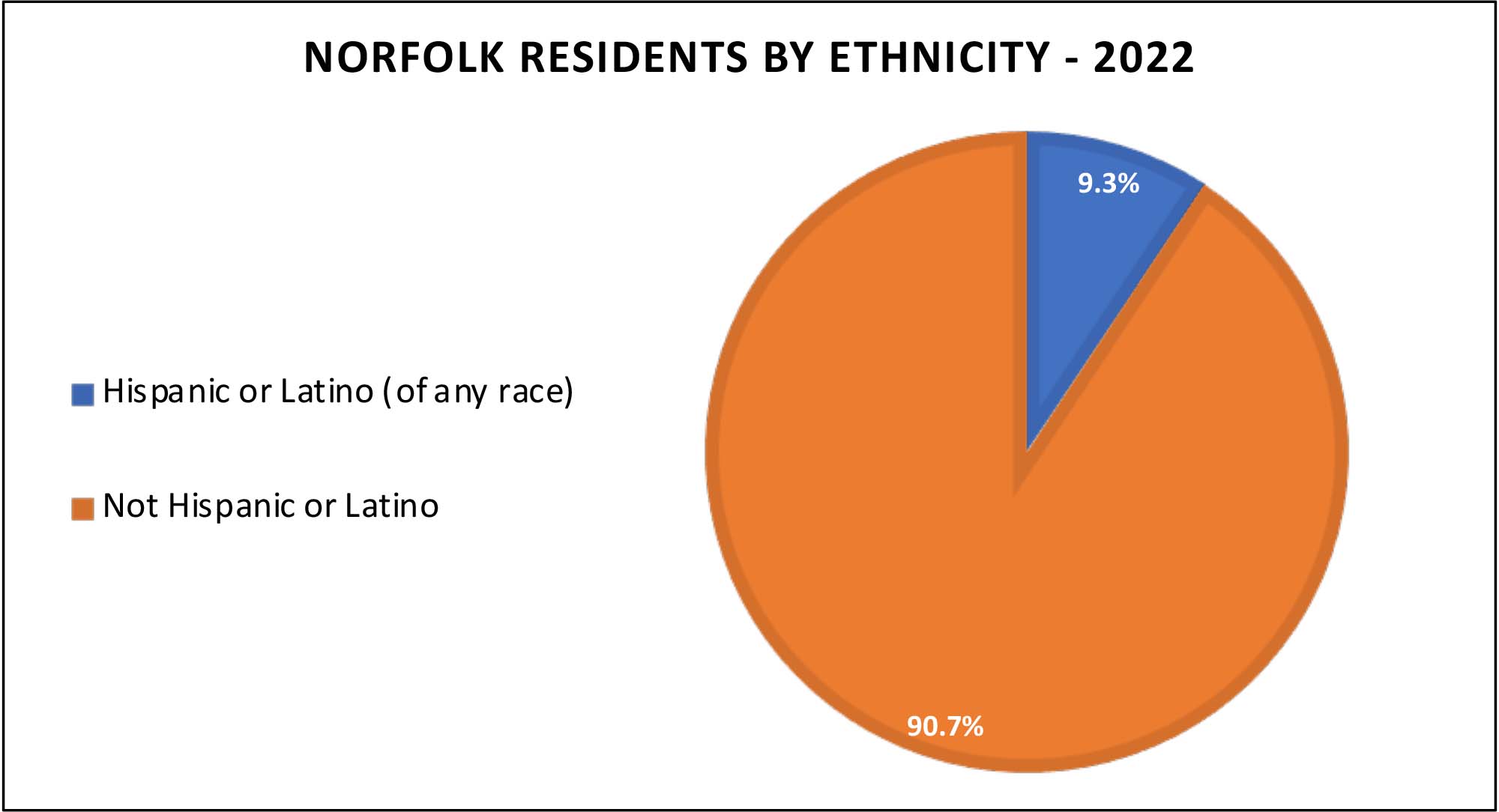
Norfolk Residents Ages 25 and Over by Educational Attainment – 2022 |
||
Educational Attainment |
Number of Residents 25 and Over | Percent of Residents 25 and Over |
| Less than High School | 12,566 | 8.4% |
| High School Graduate (includes equivalency) | 38,599 | 25.7% |
| Some College, No Degree | 38,075 | 25.4% |
| Associate’s Degree | 12,581 | 8.4% |
| Bachelor’s Degree | 27,759 | 18.5% |
| Graduate or Professional Degree | 20,462 | 13.6% |
| Total | 150,042 | 100.0% |
| Source: U.S. Census Bureau, 2022 American Community Survey 1-Year Estimates, Table S1501 – Educational Attainment | ||
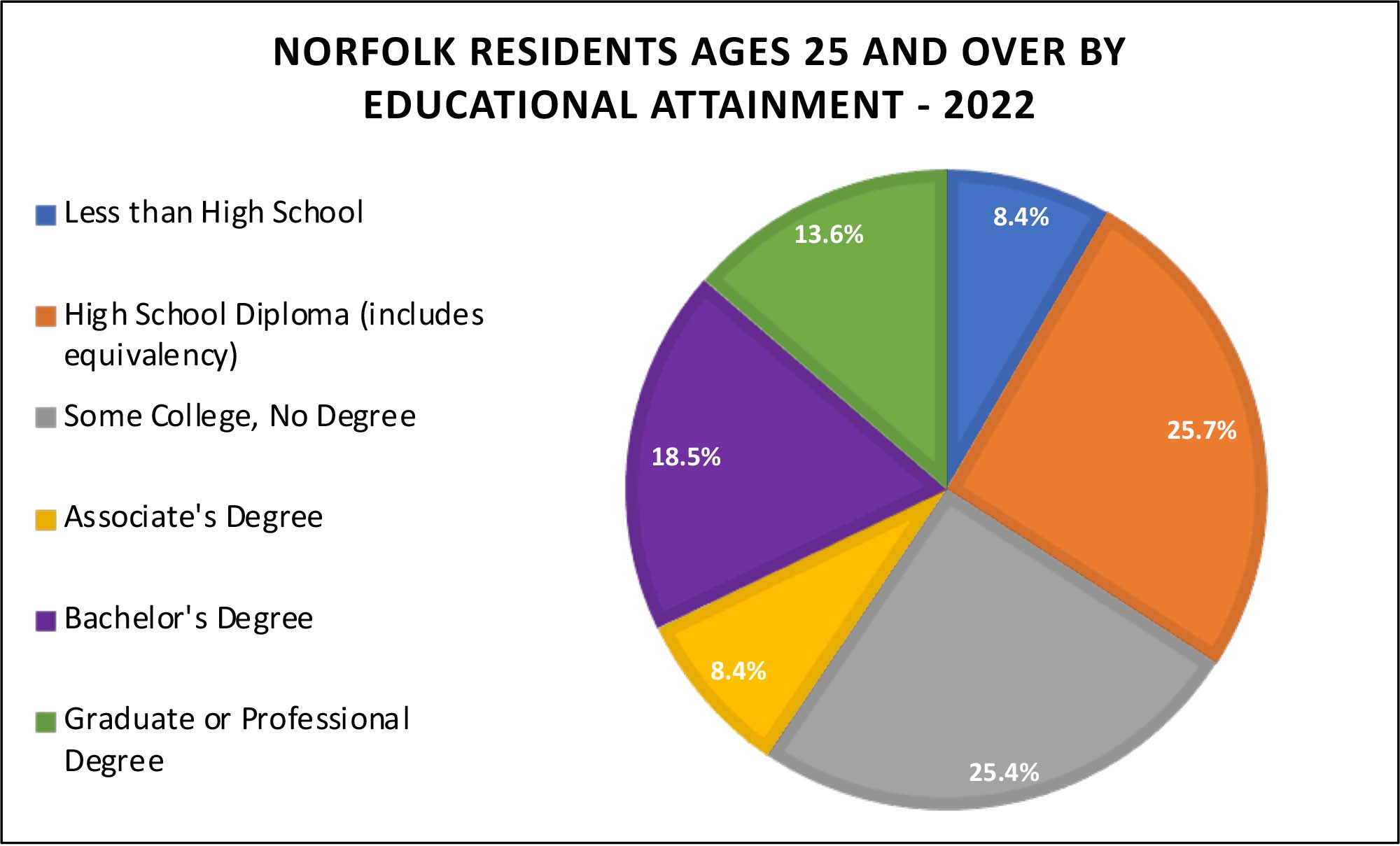
Norfolk Households by Household Income – 2022(in 2022 Inflation-Adjusted Dollars) | |
| Household Income Range | Percent of Households |
| Under $25,000 | 21.3% |
| $25,000-$49,999 | 20.7% |
| $50,000-$74,999 | 17.2% |
| $75,000-$99,999 | 11.6% |
| $100,000+ | 29.2% |
| Total Households | 94,532 |
| Household Income | Value |
| Median Household Income (dollars) | $61,090 |
| Mean Household Income (dollars) | $85,758 |
| Source: U.S. Census Bureau, 2022 American Community Survey 1-Year Estimates, Table S1901 – Income in the Past 12 Months (In 2022 Inflation-Adjusted Dollars) | |
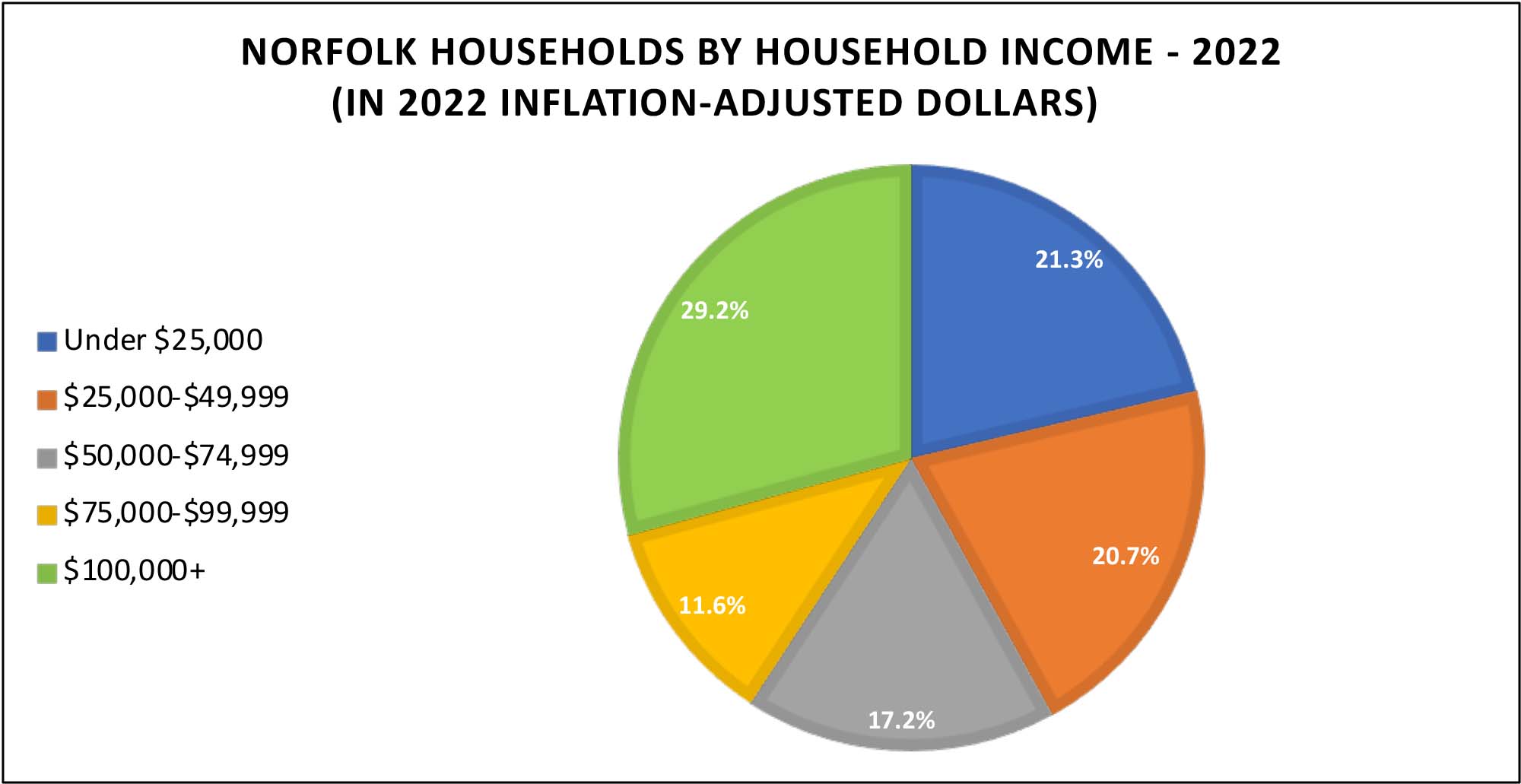
Norfolk has a variety of affordable housing options with a median housing value in Norfolk, VA, that is lower than that of the MSA, Virginia, and the United States.
Median Housing Value – 2022 | |
| Geography | Value |
| Norfolk | $269,500 |
| MSA | $318,300 |
| Virginia | $365,700 |
| United States | $320,900 |
| Source: U.S. Census Bureau, 2022 American Community Survey 1-Year Estimates, Table DP04: Selected Housing Characteristics | |
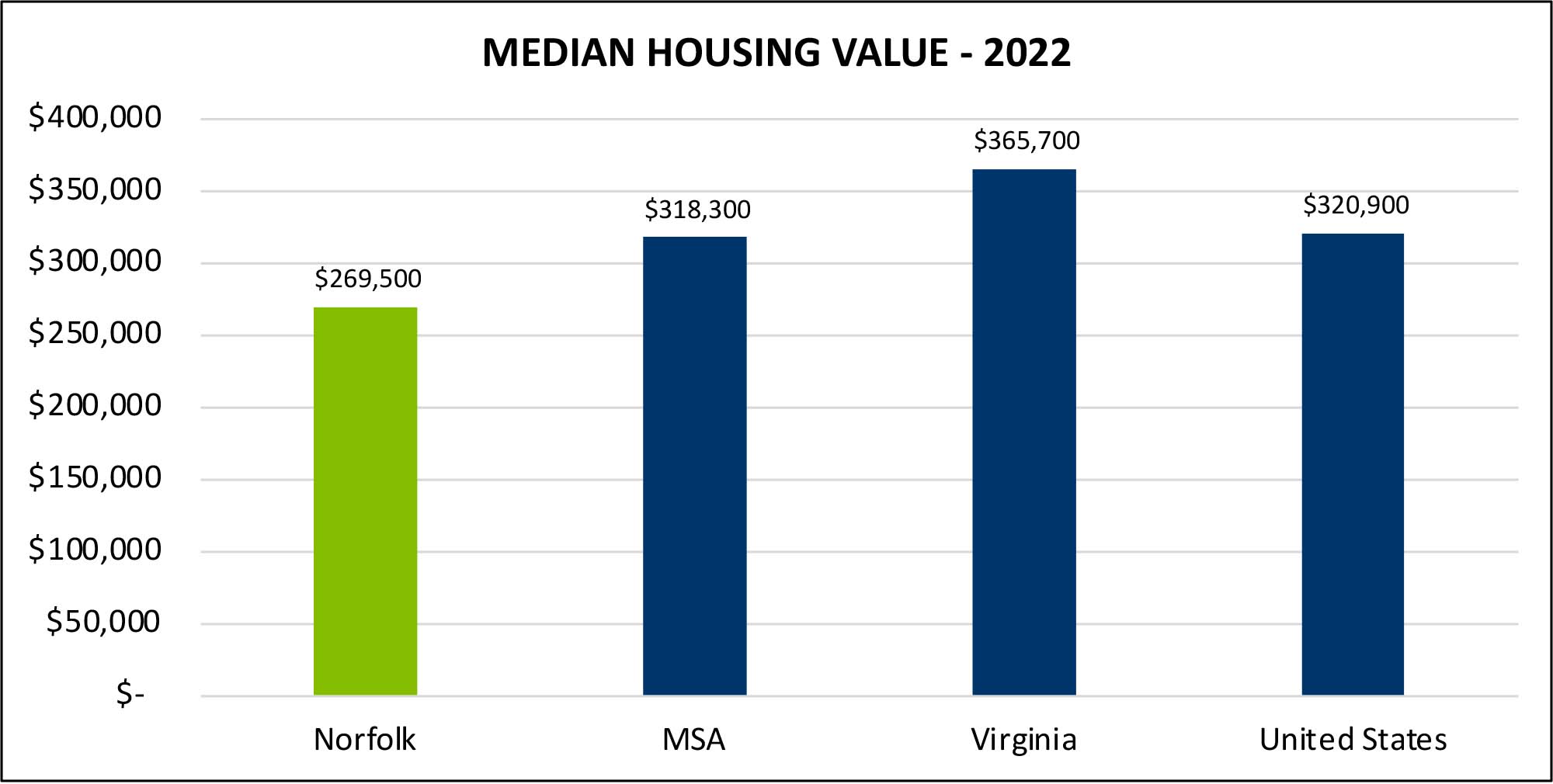
Norfolk Housing Units by Occupancy – 2022 | ||
| Category | Number of Housing Units | Percent of Housing Units |
| Occupied Housing Units | 94,532 | 91.3% |
| Vacant Housing Units | 9,041 | 8.7% |
| Total Housing Units | 103,573 | 100.0% |
| Source: U.S. Census Bureau, 2022 American Community Survey 1-Year Estimates, Table DP04: Selected Housing Characteristics | ||

Norfolk Housing Units by Owner Type – 2022 | ||
| Category | Number of Housing Units | Percent of Housing Units |
| Owner-Occupied | 45,153 | 47.8% |
| Renter-Occupied | 49,379 | 52.2% |
| Total Occupied Housing Units | 94,532 | 100.0% |
| Source: U.S. Census Bureau, 2022 American Community Survey 1-Year Estimates, Table DP04: Selected Housing Characteristics | ||

